Blog
Causes and Symptoms of Tarsal Tunnel Syndrome
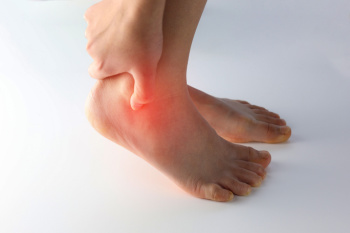
Tarsal tunnel syndrome is a condition caused by repeated pressure on the posterior tibial nerve near the ankle. It can lead to debilitating symptoms such as pain, numbness, or tingling sensations, often radiating into the sole of the foot or inside the ankle. This compression occurs within the tarsal tunnel, which is a narrow passageway bound by bone and soft tissue. Tarsal tunnel syndrome's origins include severely flat feet, benign bony growths, and varicose veins. Inflammation from arthritis, lesions or masses near the tibial nerve, and trauma from ankle sprains or fractures also may cause tarsal tunnel syndrome. Patients with conditions like diabetes are at further risk. Left untreated, tarsal tunnel syndrome can cause permanent and irreversible nerve damage that may affect mobility and hinder completing daily activities. If you suspect you may be experiencing symptoms of tarsal tunnel syndrome, it is suggested that you schedule an appointment with a podiatrist for a comprehensive evaluation and treatment plan.
Tarsal tunnel syndrome can be very uncomfortable to live with. If you are experiencing tarsal tunnel syndrome, contact Dr. Tupper of Coshocton Foot Health Center. Our doctor can provide the care you need to keep you pain-free and on your feet.
Tarsal Tunnel Syndrome
Tarsal tunnel syndrome, which can also be called tibial nerve dysfunction, is an uncommon condition of misfiring peripheral nerves in the foot. The tibial nerve is the peripheral nerve in the leg responsible for sensation and movement of the foot and calf muscles. In tarsal tunnel syndrome, the tibial nerve is damaged, causing problems with movement and feeling in the foot of the affected leg.
Common Cause of Tarsal Tunnel Syndrome
- Involves pressure or an injury, direct pressure on the tibial nerve for an extended period of time, sometimes caused by other body structures close by or near the knee.
- Diseases that damage nerves, including diabetes, may cause tarsal tunnel syndrome.
- At times, tarsal tunnel syndrome can appear without an obvious cause in some cases.
The Effects of Tarsal Tunnel Syndrome
- Different sensations, an afflicted person may experience pain, tingling, burning or other unusual sensations in the foot of the affected leg.
- The foot muscles, toes and ankle become weaker, and curling your toes or flexing your foot can become difficult.
- If condition worsens, infections and ulcers may develop on the foot that is experiencing the syndrome.
A physical exam of the leg can help identify the presence of tarsal tunnel syndrome. Medical tests, such as a nerve biopsy, are also used to diagnose the condition. Patients may receive physical therapy and prescriptive medication. In extreme cases, some may require surgery.
If you have any questions please feel free to contact our office located in Coshocton, OH . We offer the newest diagnostic and treatment technologies for all your foot and ankle needs.
Treatment of Foot Problems in Seniors

As we age, our feet undergo various changes, often leading to discomfort and mobility issues. Treatment for common foot ailments among seniors varies, depending on the condition. Bunions may require shoe modifications, custom orthotics, medication, or surgery from a podiatrist. Hammertoe deformities may necessitate changes in footwear or in some cases surgery. Toenail problems, including ingrown nails and infections, require professional attention to prevent complications, with podiatrists offering specialized care and treatment options. Seniors with diabetes must prioritize foot health and regular podiatric evaluations to prevent serious complications, such as foot ulcers or gangrene. Plantar fasciitis treatment ranges from conservative measures, such as exercises, to surgery for effective relief. Arch problems, whether flat feet or high arches, generally necessitate a non-surgical approach along with expert guidance to manage discomfort and prevent further complications. For help with any of the many foot conditions common among seniors, it is suggested that you schedule an appointment with a podiatrist for a thorough foot exam, diagnosis, and treatment options.
Proper foot care is something many older adults forget to consider. If you have any concerns about your feet and ankles, contact Dr. Tupper from Coshocton Foot Health Center. Our doctor can provide the care you need to keep you pain-free and on your feet.
The Elderly and Their Feet
As we age we start to notice many changes in our body, but the elder population may not notice them right away. Medical conditions may prevent the elderly to take notice of their foot health right away. Poor vision is a lead contributor to not taking action for the elderly.
Common Conditions
- Neuropathy – can reduce feeling in the feet and can hide many life-threatening medical conditions.
- Reduced flexibility – prevents the ability of proper toenail trimming, and foot cleaning. If left untreated, it may lead to further medical issues.
- Foot sores – amongst the older population can be serious before they are discovered. Some of the problematic conditions they may face are:
- Gouging toenails affecting nearby toe
- Shoes that don’t fit properly
- Pressure sores
- Loss of circulation in legs & feet
- Edema & swelling of feet and ankles
Susceptible Infections
Diabetes and poor circulation can cause general loss of sensitivity over the years, turning a simple cut into a serious issue.
If you have any questions please feel free to contact our office located in Coshocton, OH . We offer the newest diagnostic and treatment technologies for all your foot and ankle needs.
Reasons for Ankle Pain
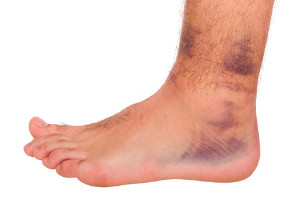
Deciphering between an ankle sprain and a strain is sometimes difficult, as both injuries share common symptoms but necessitate distinct treatment approaches. An ankle sprain occurs when ligaments, resilient bands of tissue that connect bones, endure excessive stretching or tearing. Strains are the result of damage to the muscles or tendons that surround the ankle joint. Fractures typically induce excruciating pain, rendering weight-bearing nearly impossible, while sprains often permit limited mobility despite discomfort. Furthermore, the site of discomfort varies. Fractures elicit localized pain and potential deformity, while sprains cause more diffuse discomfort. Swelling and unusual sensations such as numbness or tingling are more prevalent in fractures, indicating the urgency of proper diagnosis. Consulting a podiatrist for thorough assessment via imaging techniques like X-rays or bone scans is paramount to formulate tailored treatment strategies promptly. Whether you have an ankle sprain, strain, or fracture, timely intervention is critical to avoid long-term complications. In case of any type of ankle injury, it is suggested that you schedule an appointment with a podiatrist for a diagnosis and treatment options.
Ankle pain can have many different causes and the pain may potentially be serious. If you have ankle pain, consult with Dr. Tupper from Coshocton Foot Health Center. Our doctor will assess your condition and provide you with quality foot and ankle treatment.
Ankle pain is any condition that causes pain in the ankle. Due to the fact that the ankle consists of tendons, muscles, bones, and ligaments, ankle pain can come from a number of different conditions.
Causes
The most common causes of ankle pain include:
- Types of arthritis (rheumatoid, osteoarthritis, and gout)
- Ankle sprains
- Broken ankles
- Achilles tendinitis
- Achilles tendon rupture
- Stress fractures
- Tarsal tunnel syndrome
- Plantar fasciitis
Symptoms
Symptoms of ankle injury vary based upon the condition. Pain may include general pain and discomfort, swelling, aching, redness, bruising, burning or stabbing sensations, and/or loss of sensation.
Diagnosis
Due to the wide variety of potential causes of ankle pain, podiatrists will utilize a number of different methods to properly diagnose ankle pain. This can include asking for personal and family medical histories and of any recent injuries. Further diagnosis may include sensation tests, a physical examination, and potentially x-rays or other imaging tests.
Treatment
Just as the range of causes varies widely, so do treatments. Some more common treatments are rest, ice packs, keeping pressure off the foot, orthotics and braces, medication for inflammation and pain, and surgery.
If you have any questions, please feel free to contact our office located in Coshocton, OH . We offer the newest diagnostic and treatment technologies for all your foot care needs.
Treatment for Charcot-Marie-Tooth Neuropathy and Foot Pain
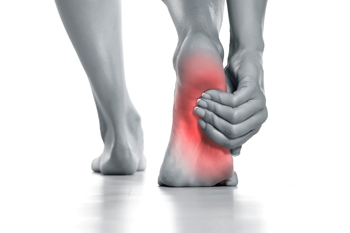
Charcot-Marie-Tooth, or CMT, is a genetic neuropathy that often results in pain. Approximately 80 percent of CMT patients experience pain, primarily in their feet and hands, which are the areas most affected by CMT. Interestingly, pain severity does not necessarily correlate with neuropathy severity. To manage CMT-related pain, several strategies exist. These can include oral and topical medications, behavioral interventions, and addressing sleep and mood issues. If you have foot neuropathy, it is suggested that you schedule an appointment with a podiatrist who can offer you a tailored approach to treatment.
Neuropathy
Neuropathy can be a potentially serious condition, especially if it is left undiagnosed. If you have any concerns that you may be experiencing nerve loss in your feet, consult with Dr. Tupper from Coshocton Foot Health Center. Our doctor will assess your condition and provide you with quality foot and ankle treatment for neuropathy.
What Is Neuropathy?
Neuropathy is a condition that leads to damage to the nerves in the body. Peripheral neuropathy, or neuropathy that affects your peripheral nervous system, usually occurs in the feet. Neuropathy can be triggered by a number of different causes. Such causes include diabetes, infections, cancers, disorders, and toxic substances.
Symptoms of Neuropathy Include:
- Numbness
- Sensation loss
- Prickling and tingling sensations
- Throbbing, freezing, burning pains
- Muscle weakness
Those with diabetes are at serious risk due to being unable to feel an ulcer on their feet. Diabetics usually also suffer from poor blood circulation. This can lead to the wound not healing, infections occurring, and the limb may have to be amputated.
Treatment
To treat neuropathy in the foot, podiatrists will first diagnose the cause of the neuropathy. Figuring out the underlying cause of the neuropathy will allow the podiatrist to prescribe the best treatment, whether it be caused by diabetes, toxic substance exposure, infection, etc. If the nerve has not died, then it’s possible that sensation may be able to return to the foot.
Pain medication may be issued for pain. Electrical nerve stimulation can be used to stimulate nerves. If the neuropathy is caused from pressure on the nerves, then surgery may be necessary.
If you have any questions, please feel free to contact our office located in Coshocton, OH . We offer the newest diagnostic and treatment technologies for all your foot care needs.
Causes and Treatment of an Achilles Tendon Injury
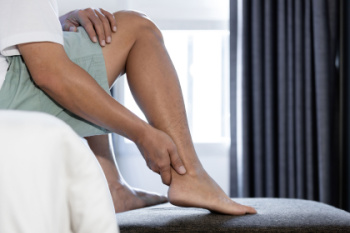
Achilles tendon injuries are common for both athletes and occasional exercisers, presenting significant challenges due to the tendon's pivotal role in mobility. Often triggered by overuse, athletes may push their limits too quickly or neglect proper stretching before physical activity. Also, factors like wearing high heels or foot issues like flat feet can heighten the risk of an Achilles tendon injury. Symptoms typically include pain along the back of the foot and above the heel, and can be worsened by ankle stretching or toe-standing. Diagnosis involves a thorough physical examination by a podiatrist, who also may order imaging tests like an ultrasound or MRI scans to assess the extent of damage. Treatment options vary based on severity and may include prescribing anti-inflammatory medication or certain exercises for rehabilitation. In severe cases or complete tears, surgery may be necessary for tendon repair. If you have injured your Achilles tendon, it is suggested that you schedule an appointment with a podiatrist for a full exam, diagnosis, and suggested treatment plan.
Achilles tendon injuries need immediate attention to avoid future complications. If you have any concerns, contact Dr. Tupper of Coshocton Foot Health Center. Our doctor can provide the care you need to keep you pain-free and on your feet.
What Is the Achilles Tendon?
The Achilles tendon is a tendon that connects the lower leg muscles and calf to the heel of the foot. It is the strongest tendon in the human body and is essential for making movement possible. Because this tendon is such an integral part of the body, any injuries to it can create immense difficulties and should immediately be presented to a doctor.
What Are the Symptoms of an Achilles Tendon Injury?
There are various types of injuries that can affect the Achilles tendon. The two most common injuries are Achilles tendinitis and ruptures of the tendon.
Achilles Tendinitis Symptoms
- Inflammation
- Dull to severe pain
- Increased blood flow to the tendon
- Thickening of the tendon
Rupture Symptoms
- Extreme pain and swelling in the foot
- Total immobility
Treatment and Prevention
Achilles tendon injuries are diagnosed by a thorough physical evaluation, which can include an MRI. Treatment involves rest, physical therapy, and in some cases, surgery. However, various preventative measures can be taken to avoid these injuries, such as:
- Thorough stretching of the tendon before and after exercise
- Strengthening exercises like calf raises, squats, leg curls, leg extensions, leg raises, lunges, and leg presses
If you have any questions please feel free to contact our office located in Coshocton, OH . We offer the newest diagnostic tools and technology to treat your foot and ankle needs.
Plantar Warts Can Be Treated!
Causes and Treatment of Plantar Warts
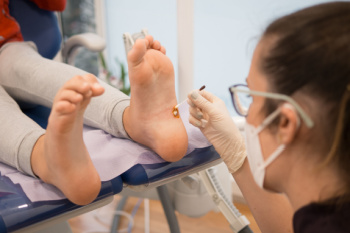
Plantar warts, also known as verrucas, can be painful and disruptive. These growths, caused by the human papillomavirus, or HPV, often appear as rough, grainy lesions on the weight-bearing areas of the foot, such as the ball and heel. Plantar warts develop when HPV infects the outer layer of skin on the foot, typically through cuts, cracks, or breaks in the skin. Certain factors, such as a weakened immune system or previous bouts of plantar warts, can increase susceptibility. Treatment options include prescription strength medications containing salicylic acid, cryotherapy, laser treatments, or surgical removal. Because it can be difficult to eradicate plantar warts on your own, a podiatrist can provide tailored treatment options to alleviate discomfort and minimize the risk of recurrence. If you have plantar warts, it is suggested that you schedule an appointment with a podiatrist for an exam and treatment options.
Plantar warts can be very uncomfortable. If you need your feet checked, contact Dr. Tupper from Coshocton Foot Health Center. Our doctor will assist you with all of your foot and ankle needs.
About Plantar Warts
Plantar warts are the result of HPV, or human papillomavirus, getting into open wounds on the feet. They are mostly found on the heels or balls of the feet.
While plantar warts are generally harmless, those experiencing excessive pain or those suffering from diabetes or a compromised immune system require immediate medical care. Plantar warts are easily diagnosed, usually through scraping off a bit of rough skin or by getting a biopsy.
Symptoms
- Lesions on the bottom of your feet, usually rough and grainy
- Hard or thick callused spots
- Wart seeds, which are small clotted blood vessels that look like little black spots
- Pain, discomfort, or tenderness of your feet when walking or standing
Treatment
- Freezing
- Electric tool removal
- Laser Treatment
- Topical Creams (prescription only)
- Over-the-counter medications
To help prevent developing plantar warts, avoid walking barefoot over abrasive surfaces that can cause cuts or wounds for HPV to get into. Avoiding direct contact with other warts, as well as not picking or rubbing existing warts, can help prevent the further spread of plantar warts. However, if you think you have developed plantar warts, speak to your podiatrist. He or she can diagnose the warts on your feet and recommend the appropriate treatment options.
If you have any questions please feel free to contact our office located in Coshocton, OH . We offer the newest diagnostic and treatment technologies for all your foot and ankle needs.
Causes and Symptoms of Charcot Foot
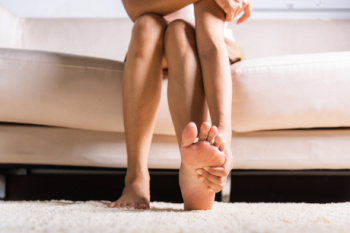
Charcot foot is a progressive condition that affects the bones and joints in the feet and ankles. It poses significant risks for people with diabetes and peripheral neuropathy. One primary cause of Charcot foot is diabetes that exceeds ten years. Further, autonomic neuropathy leads to abnormal bone formation, while sensory neuropathy causes a lack of sensation in the feet that makes them susceptible to trauma. Symptoms of Charcot foot include warmth, redness, and painless swelling in the affected foot. The bottom of the foot may become rounded, also known as rocker bottom, caused by the collapsed bones. Left untreated, Charcot foot can lead to severe complications, including foot ulcers and limb loss. Treatment includes total contact casting, which limits weight bearing for up to three months, as well as necessary wound care. If you have symptoms of Charcot foot, it is suggested that you schedule an appointment with a podiatrist.
Foot Pain
Foot pain can be extremely painful and debilitating. If you have a foot pain, consult with Dr. Tupper from Coshocton Foot Health Center. Our doctor will assess your condition and provide you with quality foot and ankle treatment.
Causes
Foot pain is a very broad condition that could be caused by one or more ailments. The most common include:
- Bunions
- Hammertoes
- Plantar Fasciitis
- Bone Spurs
- Corns
- Tarsal Tunnel Syndrome
- Ingrown Toenails
- Arthritis (such as Gout, Rheumatoid, and Osteoarthritis)
- Flat Feet
- Injury (from stress fractures, broken toe, foot, ankle, Achilles tendon ruptures, and sprains)
- And more
Diagnosis
To figure out the cause of foot pain, podiatrists utilize several different methods. This can range from simple visual inspections and sensation tests to X-rays and MRI scans. Prior medical history, family medical history, and any recent physical traumatic events will all be taken into consideration for a proper diagnosis.
Treatment
Treatment depends upon the cause of the foot pain. Whether it is resting, staying off the foot, or having surgery; podiatrists have a number of treatment options available for foot pain.
If you have any questions, please feel free to contact our office located in Coshocton, OH . We offer the newest diagnostic and treatment technologies for all your foot care needs.
Children’s Growing Pains or Serious Foot Concern?
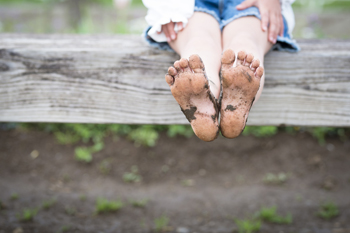 Growing pains are a normal part of development in childhood. Children may experience mild aches or discomfort in the legs and feet due to the rapid growth phases they go through. Typically, these pains occur at night and don’t continue into the following day. However, when children’s foot pain deviates from these patterns, such as being localized, persistent, or severe, it may indicate a more profound issue. For instance, pain that worsens with activity could suggest Sever's disease, an inflammation of the heel's growth plate. Swelling, redness, or tenderness could point towards juvenile idiopathic arthritis. Something else may be amiss if there is a noticeable change in a child’s gait, like limping or reluctance to engage in previously enjoyed activities. If you’re unsure about whether your child is experiencing normal growing pains or something more, it is time for a visit with a foot doctor, otherwise known as a podiatrist. This type of doctor can diagnose any issues, and offer appropriate care and intervention to ensure the best foot health for your child.
Growing pains are a normal part of development in childhood. Children may experience mild aches or discomfort in the legs and feet due to the rapid growth phases they go through. Typically, these pains occur at night and don’t continue into the following day. However, when children’s foot pain deviates from these patterns, such as being localized, persistent, or severe, it may indicate a more profound issue. For instance, pain that worsens with activity could suggest Sever's disease, an inflammation of the heel's growth plate. Swelling, redness, or tenderness could point towards juvenile idiopathic arthritis. Something else may be amiss if there is a noticeable change in a child’s gait, like limping or reluctance to engage in previously enjoyed activities. If you’re unsure about whether your child is experiencing normal growing pains or something more, it is time for a visit with a foot doctor, otherwise known as a podiatrist. This type of doctor can diagnose any issues, and offer appropriate care and intervention to ensure the best foot health for your child.
Making sure that your children maintain good foot health is very important as they grow. If you have any questions, contact Dr. Tupper of Coshocton Foot Health Center. Our doctor can provide the care you need to keep you pain-free and on your feet.
Keeping Children's Feet Healthy
Having healthy feet during childhood can help prevent medical problems later in life, namely in the back and legs. As children grow, their feet require different types of care. Here are some things to consider...
Although babies do not walk yet, it is still very important to take care of their feet.
Avoid putting tight shoes or socks on his or her feet.
Allow the baby to stretch and kick his or her feet to feel comfortable.
As a toddler, kids are now on the move and begin to develop differently. At this age, toddlers are getting a feel for walking, so don’t be alarmed if your toddler is unsteady or ‘walks funny’.
As your child gets older, it is important to teach them how to take care of their feet.
Show them proper hygiene to prevent infections such as fungus.
Be watchful for any pain or injury.
Have all injuries checked by a doctor as soon as possible.
Comfortable, protective shoes should always be worn, especially at play.
If you have any questions please feel free to contact our office located in Coshocton, OH . We offer the newest diagnostic and treatment technologies for all your foot and ankle needs.
Non-Surgical Treatments for Bunions
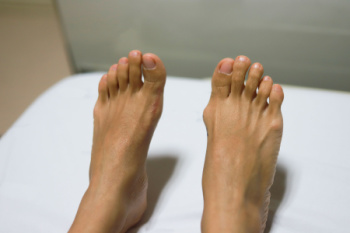
Non-surgical treatments for bunions focus on relieving pain and discomfort, as well as slowing down the progression of the condition. Treatments include wearing comfortable shoes with a wide toe box to reduce pressure on the bunion, using padded inserts or orthotic devices to provide support and cushioning, and resting the foot to reduce swelling and inflammation. Toe spacers or splints may be used to help realign the toes gradually. Stretching and strengthening exercises for the foot and toe muscles can also improve flexibility and stability. While these treatments may not correct the bunion entirely, they can alleviate symptoms and improve quality of life for individuals with bunions who wish to avoid surgery. If you have a bunion that is causing discomfort, it is suggested that you visit a podiatrist regularly to track its progression, and adjust treatment as needed.
If you are suffering from bunion pain, contact Dr. Tupper of Coshocton Foot Health Center. Our doctor can provide the care you need to keep you pain-free and on your feet.
What Is a Bunion?
Bunions are painful bony bumps that usually develop on the inside of the foot at the joint of the big toe. As the deformity increases over time, it may become painful to walk and wear shoes. Women are more likely to exacerbate existing bunions since they often wear tight, narrow shoes that shift their toes together. Bunion pain can be relieved by wearing wider shoes with enough room for the toes.
Causes
- Genetics – some people inherit feet that are more prone to bunion development
- Inflammatory Conditions - rheumatoid arthritis and polio may cause bunion development
Symptoms
- Redness and inflammation
- Pain and tenderness
- Callus or corns on the bump
- Restricted motion in the big toe
In order to diagnose your bunion, your podiatrist may ask about your medical history, symptoms, and general health. Your doctor might also order an x-ray to take a closer look at your feet. Nonsurgical treatment options include orthotics, padding, icing, changes in footwear, and medication. If nonsurgical treatments don’t alleviate your bunion pain, surgery may be necessary.
If you have any questions, please feel free to contact our office located in Coshocton, OH . We offer the newest diagnostic and treatment technologies for all your foot care needs.
More...
How Diabetes Affects the Feet
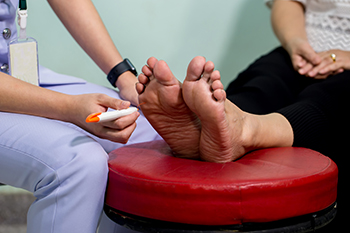
Living with diabetes brings a multitude of challenges, with one often overlooked aspect being the health of your feet. Diabetes can lead to significant complications in foot health, including ulcers, nerve damage, and infections. Uncontrolled diabetes can cause nerve damage, resulting in reduced sensation in the feet, which is a condition known as diabetic neuropathy. This loss of feeling can indicate that minor injuries or irritations may go unnoticed, and increases the likelihood of them turning into more severe problems like ulcers. Additionally, diabetes can damage the arteries supplying the nerves, furthering nerve damage and impairing circulation. Regular foot checks by a podiatrist are essential for individuals with diabetes. These visits will monitor foot health, identify early signs of complications, and guidance will be received on proper foot care techniques. If you have foot problems that may be the result of diabetes, it is suggested that you schedule regular visits to a podiatrist who is medically trained to manage this condition.
Diabetic foot care is important in preventing foot ailments such as ulcers. If you are suffering from diabetes or have any other concerns about your feet, contact Dr. Tupper from Coshocton Foot Health Center. Our doctor can provide the care you need to keep you pain-free and on your feet.
Diabetic Foot Care
Diabetes affects millions of people every year. The condition can damage blood vessels in many parts of the body, especially the feet. Because of this, taking care of your feet is essential if you have diabetes, and having a podiatrist help monitor your foot health is highly recommended.
The Importance of Caring for Your Feet
- Routinely inspect your feet for bruises or sores.
- Wear socks that fit your feet comfortably.
- Wear comfortable shoes that provide adequate support.
Patients with diabetes should have their doctor monitor their blood levels, as blood sugar levels play such a huge role in diabetic care. Monitoring these levels on a regular basis is highly advised.
It is always best to inform your healthcare professional of any concerns you may have regarding your feet, especially for diabetic patients. Early treatment and routine foot examinations are keys to maintaining proper health, especially because severe complications can arise if proper treatment is not applied.
If you have any questions please feel free to contact our office located in Coshocton, OH . We offer the newest diagnostic and treatment technologies for all your foot and ankle needs.
Symptoms of Turf Toe

Turf toe, a common injury among athletes, occurs when the ligaments surrounding the big toe joint are sprained due to forceful pushing during activities like running or jumping. Turf toe injuries typically happen during sports practice, and are common in football and soccer. An early sign of turf toe is foot pain, which often intensifies with movement. This discomfort may lead to limping or difficulty in walking, occasionally rendering you immobile for a brief period. Sometimes a popping sound in the joint may indicate turf toe. Severe cases may necessitate immobilization or even surgery. It is extremely important not to ignore symptoms of turf toe, as early intervention can accelerate recovery and prevent long-term complications. If you are experiencing persistent pain or limited mobility in your big toe joint, it is suggested that you schedule an appointment with a podiatrist for a diagnosis. This medically trained foot doctor can perform imaging tests, a physical examination, and develop a treatment plan to address your specific needs.
Toe pain can disrupt your daily activities. If you have any concerns, contact Dr. Tupper of Coshocton Foot Health Center. Our doctor can provide the care you need to keep you pain-free and on your feet.
What Causes Toe Pain?
Most severe toe pain is caused due to a sports injury, trauma from dropping something heavy on the toe, or bumping into something rigid. Other problems can develop over time for various reasons.
Toe pain can be caused by one or more ailments. The most common include:
- Trauma
- Sports injury
- Wearing shoes that are too tight
- Arthritis
- Gout
- Corns and calluses
- Hammertoe
- Bunions
- Blisters
- Ingrown toenails
- Sprains
- Fractures (broken bones)
- Dislocations
When to See a Podiatrist
- Severe pain
- Persistent pain that lasts more than a week
- Signs of infection
- Continued swelling
- Pain that prevents walking
Diagnosis
In many cases the cause of toe pain is obvious, but in others, a podiatrist may want to use more advanced methods to determine the problem. These can range from simple visual inspections and sensation tests to X-rays and MRI scans. Prior medical history, family medical history, and any recent physical traumatic events will all be taken into consideration for a proper diagnosis.
Treatment
Treatments for toe pain and injuries vary and may include shoe inserts, padding, taping, medicines, injections, and in some cases, surgery. If you believe that you have broken a toe, please see a podiatrist as soon as possible.
If you have any questions please feel free to contact our office located in Coshocton, OH . We offer the newest diagnostic tools and technology to treat your foot and ankle needs.




